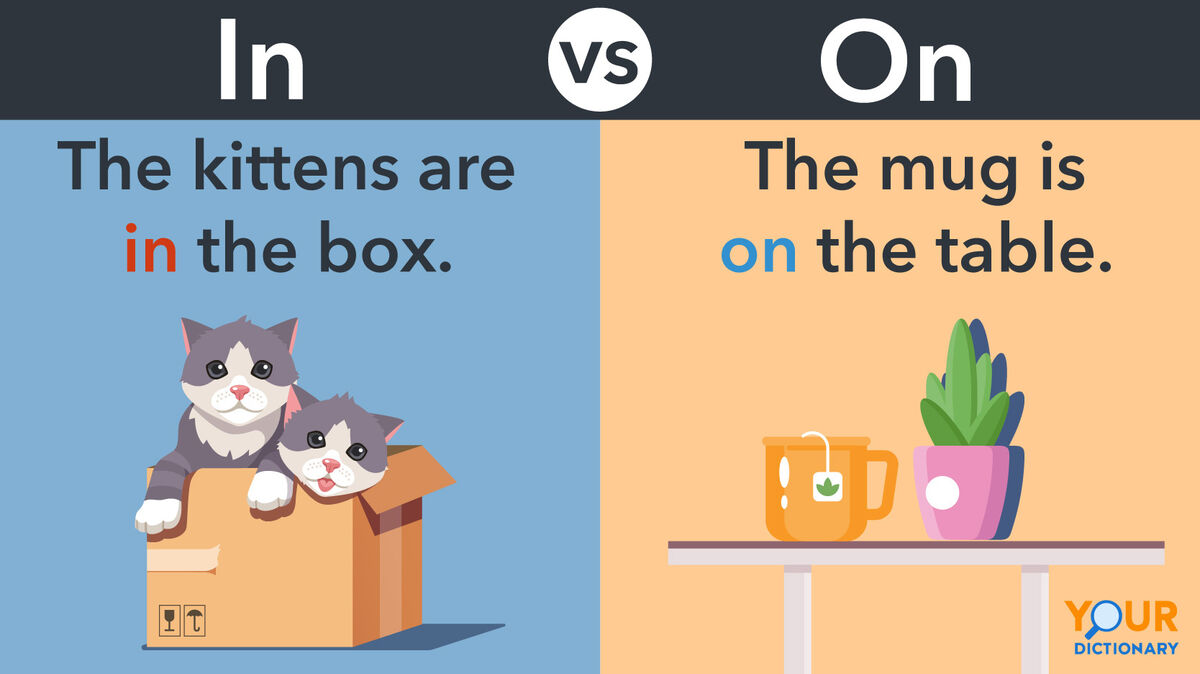
The prepositions in and on may be short, but these two-letter words often trip English speakers up. Explore the correct usage of in and on, their basic definitions and several examples of each.
How to Use In vs. On
Sometimes the use of in and on can be confusing, especially in context. Use this simple chart to help you remember the difference between them.
Use: | In | On |
Meaning | something inside or enclosed by something else | something resting upon or atop something else |
Time | months, years, seasons, decades, centuries | days, dates, holidays, special occasions |
Place | enclosed spaces; buildings; regions; space; nature; names of towns, cities, states, countries, and continents | surfaces, roads, streets, islands, planets, public transportation, bikes, boats, stairs, planets |
How to Use In
The function of in as a preposition is to indicate something is inside something else or, more abstractly, to measure time. It is used when you want to indicate a position within a general space.
Using In to Indicate Place
In is defined as being inside an area or residing somewhere. This applies to a town, city, state, country, or residence.
I’m in the building now.
I live in California.
She’s in her room.
Using In to Indicate Location
The word in typically denotes location. Each of these examples shows someone or something moving from a point outside to a point inside.
The dog is in her bed.
Let’s go in.
She moved in with her boyfriend this weekend.
Using In to Indicate Time
In is also used to indicate times of the day, months, years, and seasons.
I love to journal in the morning.
The yellow roses will bloom in April.
I’ll be with you in a moment.
Using In to Indicate Occupation
Furthermore, in is used to note a specific occupation or function that someone has. For example:
She works in the Department of Justice.
He works in nanotechnology.
I work in the HR department.
How to Use On
On is used to indicate position, usually indicating that something is on top of something else. It is also used when you want to indicate a position above or atop a space.
Using On to Indicate Position
On indicates a position atop a surface or just above or outside a given area.
My journal is on the desk.
He sat on the stone wall.
She placed the star on the tree.
Using On to Indicate Dates and Times
While in is used for larger spans of time such as months and seasons, on is also used to indicate specific days, dates and specific times. For example:
He left on the morning of May 18.
We look forward to your gifts on Christmas Eve.
On that day, everything changed.
Meaning and Examples of Into and Onto
Into is defined as moving from the outside to the inside, similar to in. Into is used when you want to indicate that someone or something is moving from one place to another, not just moving into a limited or specific space. Additionally, into can be used to say that someone is interested in something or indicate someone is involved in something. For example:
He walked into the ballroom.
I’m really into rock music.
I’m thinking about going into politics.
Onto refers to something or someone’s position on top of something, literally or figuratively.
He got onto his bike.
I’m onto you.
She climbed onto the roof.
Preposition Practice
Prepositions are connectors. While learning all the rules and uses is important, you do not have to do so all at once. Begin by studying this list of common prepositions and committing them to memory. Then, familiarize yourself with the rules for prepositions. Once you’ve learned the basics, you’re ready to tackle prepositional phrases.